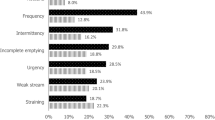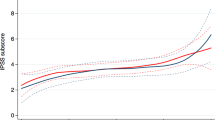Abstract
This questionnaire-based survey evaluated the frequency and severity of lower urinary tract symptoms (LUTS) and the prevalence of enlarged prostate (EP) diagnosis and its impact on quality of life and spousal relationships among >1000 American men aged >50 years. A quarter of men suffered moderate to severe LUTS and 55% of those consulting a doctor had EP. EP negatively affected patient quality of life and caused relationship strain with spouses. These findings confirm that LUTS and EP are prevalent in the US population, affecting both patient and spouse, and may help in developing management strategies for EP.
This is a preview of subscription content, access via your institution
Access options
Subscribe to this journal
Receive 4 print issues and online access
$259.00 per year
only $64.75 per issue
Buy this article
- Purchase on Springer Link
- Instant access to full article PDF
Prices may be subject to local taxes which are calculated during checkout






Similar content being viewed by others
References
Emberton M, Andriole GL, de la Rosette J, Djavan B, Hoefner K, Vela Navarrete R et al. Benign prostatic hyperplasia: a progressive disease of aging men. Urology 2003; 61: 267–273.
Jacobsen SJ, Girman CJ, Guess HA, Rhodes T, Oesterling JE, Lieber MM . Natural history of prostatism: longitudinal changes in voiding symptoms in community dwelling men. J Urol 1996; 155: 595–600.
Jacobsen SJ, Jacobson DJ, Girman CJ, Roberts RO, Rhodes T, Guess HA et al. Natural history of prostatism: risk factors for acute urinary retention. J Urol 1997; 158: 481–487.
McConnell JD, Roehrborn CG, Bautista OM, Andriole Jr GL, Dixon CM, Kusek JW et al. The long-term effect of doxazosin, finasteride, and combination therapy on the clinical progression of benign prostatic hyperplasia. N Engl J Med 2003; 349: 2387–2398.
DuBeau CE, Yalla SV, Resnick NM . Implications of the most bothersome prostatism symptom for clinical care and outcomes research. J Am Geriatr Soc 1995; 43: 985–992.
Rhodes T, Girman CJ, Jacobsen SJ, Guess HA, Hanson KA, Oesterling JE et al. Does the mode of questionnaire administration affect the reporting of urinary symptoms? Urology 1995; 46: 341–345.
Jacobsen SJ, Girman CJ, Lieber M . Natural history of benign prostatic hyperplasia. Urology 2001; 58: 5–16.
Chute CG, Panser LA, Girman CJ, Oesterling JE, Guess HA, Jacobsen SJ et al. The prevalence of prostatism: a population-based survey of urinary symptoms. J Urol 1993; 150: 85–89.
Garraway WM, Collins GN, Lee RJ . High prevalence of benign prostatic hypertrophy in the community. Lancet 1991; 338: 469–471.
Bosch JL, Hop WC, Kirkels WJ, Schroder FH . The International Prostate Symptom Score in a community-based sample of men between 55 and 74 years of age: prevalence and correlation of symptoms with age, prostate volume, flow rate and residual urine volume. Br J Urol 1995; 75: 622–630.
Choong S, Emberton M . Acute urinary retention. Br J Urol Int 2000; 85: 186–201.
Author information
Authors and Affiliations
Corresponding author
Rights and permissions
About this article
Cite this article
Roehrborn, C., Marks, L. & Harkaway, R. Enlarged prostate: A landmark national survey of its prevalence and impact on US men and their partners. Prostate Cancer Prostatic Dis 9, 30–34 (2006). https://doi.org/10.1038/sj.pcan.4500841
Received:
Accepted:
Published:
Issue Date:
DOI: https://doi.org/10.1038/sj.pcan.4500841
Keywords
This article is cited by
-
Is Race Associated with the Surgical Treatment for Benign Prostatic Hyperplasia? An Analysis of 30,000 Medicare Lives
Journal of Racial and Ethnic Health Disparities (2024)
-
Pharmacotherapy vs. minimally invasive therapies as initial therapy for moderate-to-severe benign prostatic hyperplasia: a cost-effectiveness study
Prostate Cancer and Prostatic Diseases (2023)
-
Free combination of dutasteride plus tamsulosin for the treatment of benign prostatic hyperplasia in South Korea: analysis of drug utilization and adverse events using the National Health Insurance Review and Assessment Service database
BMC Urology (2021)
-
Cellular senescence as a possible link between prostate diseases of the ageing male
Nature Reviews Urology (2021)
-
Preservation of antegrade ejaculation after surgical relief of benign prostatic obstruction is a valid endpoint
World Journal of Urology (2021)



